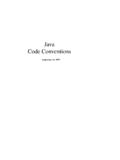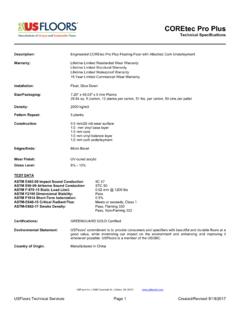Transcription of Effect of Indentation Load and Time on Knoop and …
1 Materials Research, Vol. 12, No. 4, 473-476, 2009 2009*e-mail: of Indentation load and Time on Knoop and vickers microhardness tests for enamel and DentinChanya Chuenarrom*, Pojjanut Benjakul, Paitoon DaosodsaiDepartment of Prosthetic Dentistry, Faculty of Dentistry, Prince of Songkla University, Songkhla, ThailandReceived: July 1, 2009; Revised: October 27, 2009 The aim of this study was to determine the Effect of variations in Indentation load and time on the Knoop and vickers hardness numbers (KHN and VHN) for enamel and dentin. Twenty molar teeth were divided into twenty enamel and twenty dentin specimens. Each specimen was tested using a Knoop or vickers microhardness tester at different loads and times. The difference in hardness between the groups was analyzed with two-way ANOVA followed by a Tukey test. The results revealed that a difference of Indentation time did not influence the microhardness number of enamel and dentin.
2 The KHN values of enamel and the VHN values of dentin were affected by variation of test loads. Therefore, the tooth hardness number for different loads may not be acceptable for : dentin, enamel , Knoop hardness, vickers hardness1. IntroductionMicrohardness tests are commonly used to study the physical properties of materials, and they are widely used to measure the hardness of teeth1-3. This method is easy, quick, and requires only a tiny area of specimen surface for testing. Using this technique, the specimen surfaces were impressed with a diamond indenter (a Knoop or a vickers ) at a certain load for a certain period of time. After load removal, diagonals of the Indentation were measured with an optical microscope. The hardness number was defined by the ratio between the Indentation load and the area of the residual impression, which depended on the indenter shape.
3 Then the hardness of materials was calculated using these equations:HK = 14230 (F/d2) for Knoop microhardnessor HV = 1854 (F/d2) for vickers microhardnessThe constant value of each equation was calculated from the specific geometry of the indenter; F was the Indentation load (g), and d was the diagonal of the Indentation ( m). The Indentation load for the microhardness test can be performed using 1 to 1,000 g, and with various loading times. There is no agree-ment on the specifications of the conditions for the test method of a tooth. An examination of the literature reveals that previous studies have used different indenters and various loads and times to investi-gate the hardness of enamel and the HK and HV equations, the microhardness value should be constant when loads are varied, because the Indentation size in-creases with an increase in the load .
4 However, studies of microhard-ness results on a wide range of loads have shown that results are not constant at very low loads9. This characteristic can be attributed to elastic recovery or the viscoelastic nature10, the grain size effect11, in-dentation cracks, surface texture, or diagonal measurement errors12. enamel and dentin have specific microstructures; thus their hard-ness may depend upon Indentation loads or times. The lack of this information makes it difficult to compare the results of prior studies which had the same purpose, but which used different Indentation loads and times. The aim of this study was to evaluate the Effect of Indentation loads and times on Knoop and vickers microhardness tests for human enamel and Materials and MethodsTwenty enamel specimens and twenty dentin specimens were prepared from twenty human third molar teeth.
5 Each tooth was cut longitudinally, to separate the buccal and lingual halves, using a diamond blade saw (IsoMet 4000, Buehler, USA). Each specimen was then embedded in a resin block. The middle region of the buccal half was ground to provide a flat surface approximately 2 2 mm2 using silicon carbide paper with grit sizes 320, 600 and 1200, and polished using 1 m diamond suspension. enamel from the lingual half was removed to expose a dentin surface approximately 3 3 mm2, to serve as a dentin specimen. Ten enamel specimens and ten dentin specimens were used for a vickers microhardness test; the other ten enamel and ten dentin specimens were used for a Knoop micro-hardness test. Using a microhardness tester (Micromet II, Buehler, USA), each enamel specimen was impressed with loads of 100, 200 and 300 g for 10, 20 and 30 seconds, and each dentin specimen with Indentation loads of 10, 25 and 50 g for 10, 20 and 30 seconds using a Knoop or a vickers indenter.
6 The minimum spacing of indents was times the indent diagonal, as demonstrated in Figure 1. Each test condition with the same load and time was conducted three times; thus there were 27 indentations on each specimen surface obtained from different test loads and times. An average of three readings for each test condition was recorded as the KHN or VHN value of a speci-men. Data of each experimental condition from ten specimens were averaged, and differences in KHN or VHN values were compared using two-way ANOVA followed by a Tukey test. 474 Chuenarrom et Research3. ResultsThe results of the Knoop and vickers hardness tests for enamel and dentin at different test loads and times are shown in Figures 2-5. For enamel , the average KHN values are in the range of 2, while VHN values are in the range of 2.
7 For dentin, under the same testing conditions, the data shows without ambiguity that KHN values, which varied from to 2, are higher than VHN values, which varied from to 2. In Table 1, two-way analysis of variance revealed statistically significant differences at different Indentation loads in KHN of enamel and VHN of dentin. Multiple comparison with a Tukey test revealed that for various loading times the average KHN value of enamel at a load of 100 g differed from a load of 300 g. Also the average VHN value of dentin at a load of 10 g differed from loads of 25 and 50 g. However, there were no statistically significant differences of VHN values in enamel and KHN values in dentin at different loads. Differ-ent Indentation times did not affect these test results. The interaction between different loads and different times was tested, but showed no statistical 1.
8 Group of vickers indentations on enamel at different loads and 2. Average KHN values (SD) of enamel at different Indentation loads and 3. Average VHN values (SD) of enamel at different Indentation loads and 4. Average KHN values (SD) of dentin at different Indentation loads and 5. Average VHN values (SD) of dentin at different Indentation loads and 12, No. 4, 2009 Effect of Indentation load and Time on Knoop and vickers microhardness tests for enamel and Dentin4754. DiscussionThere is no standard condition for enamel and dentin microhard-ness testing; therefore, selection of testing conditions depended on the researcher s decision. Numerous previous microhardness studies reported results of both KHN and VHN at different Indentation loads and times4-8,13-15. There are many reasons to perform tests at different conditions.
9 A high load is chosen for the reason that it produces a large impression, and it is thus easy to measure the Indentation diagonal. However, a high load applied on a soft surface causes an oversize impression, where the diagonals are longer than the micrometer scale fitted to the eyepiece of the tester. Therefore in a pre-post ex-perimental study of, for instance, enamel erosion, it is necessary to apply a small load for a comparison between the baseline surface and the eroded surface for the same Indentation load . Guti rrez-Salazar and Reyes-Gasga16 proposed that in tooth hardness studies the Vick-ers indenter is more useful than the Knoop because a square shape must always be conserved, and because the Indentation produced on a non-flat surface, or by the difference in hardness of enamel and dentin, is easily detected.
10 Meredith et reported that the Knoop has been the most popular method. Knoop Indentation is longer and shallower than vickers Indentation , so a load impression can be ap-plied to brittle materials without cracking. Plus, the longer diagonal is easier to read than the short diagonal of the vickers . However in this study, the advantage of the Knoop s longer diagonal was offset by the difficulty in deciding where the tapered tip ends on the surface of the dentin. Without considering variations of Indentation loads and time, the results obtained for the KHN and VHN values of enamel and dentin in this study are in accordance with previously published values: for example, the hardness of enamel has been reported in the range of 314 to 361 KHN18 or 322 to 353 VHN6. For dentin, the hardness has been reported in the range of 52 to 64 KHN14,19 or 46 to 53 VHN15.


















